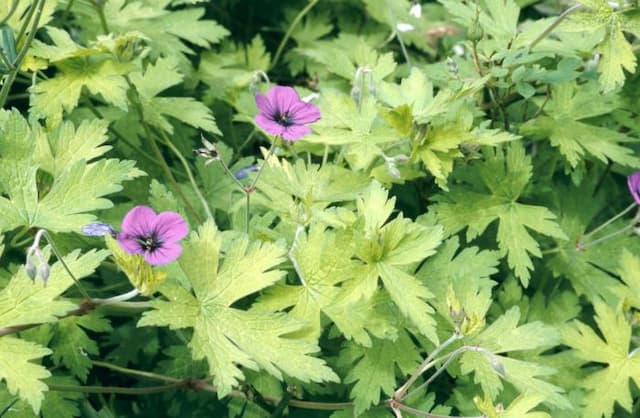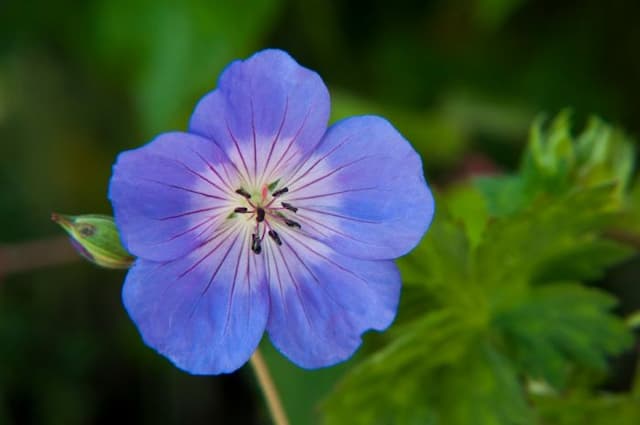Geranium Pelargonium Tornado Series (I)

ABOUT
Pelargonium Tornado Series (I) is characterized by its vibrant and eye-catching appearance. Known commonly as geraniums, these plants are particularly admired for their lush foliage and showy flowers. The leaves of the geranium are typically rounded with a soft, velvety texture, often displaying a zonal pattern in the form of a darker horseshoe mark on the surface. These patterns contribute to the ornamental value of the plant. The flowers of the Tornado Series geraniums are a true spectacle, blooming in clusters called umbels, with each cluster consisting of many individual florets. The petals are shaped in a way that they may appear to resemble little trumpets, contributing to the "tornado" effect which is integral to the descriptive naming of the series. The color palette of these flowers varies widely within the series, with possible colors ranging from bright reds to soft pinks, purples, whites, and even multicolored varieties that combine shades in various patterns and gradients. The overall appearance of the geranium is one that is dense and full, creating an impression of lushness that is well-suited for container gardening, hanging baskets, and as a feature in flower beds and borders. The vibrant blooms sit atop the foliage, adding a burst of color that can be seen from a distance, making the Pelargonium Tornado Series a popular choice for gardeners looking to add a touch of drama to their floral displays.
About this plant
 Names
NamesFamily
Geraniaceae
Synonyms
Ivy Geranium, Cascading Geranium
Common names
Pelargonium Tornado Series
 Toxicity
ToxicityTo humans
The plant commonly known as geranium, particularly the Pelargonium Tornado Series, is generally considered non-toxic to humans. However, ingesting large quantities of any part of the plant might cause mild stomach upset. Such occurrences are rare, as the plant is not typically consumed.
To pets
Geraniums, including the Pelargonium Tornado Series, are known to be toxic to pets, particularly dogs and cats. If ingested, pets can experience symptoms such as vomiting, depression, skin rashes, and anorexia. In more severe cases, there might be lethargy, loss of appetite, and dermatitis. Pet owners should prevent their pets from eating geraniums to avoid these potential consequences.
 Characteristics
CharacteristicsLife cycle
Annuals
Foliage type
Evergreen
Color of leaves
Green
Flower color
Mixed
Height
1-2 feet (30-60 cm)
Spread
1-2 feet (30-60 cm)
Plant type
Herb
Hardiness zones
9
Native area
South Africa
Benefits
 General Benefits
General Benefits- Vibrant Colors: Offers a range of vivid and bright flower colors that can enhance the aesthetic appeal of any garden or space.
- Long Blooming Period: Has a prolonged flowering season, providing continuous color throughout spring and summer.
- Drought Tolerance: Once established, it is relatively drought-resistant, making it suitable for warm climates and reducing the need for frequent watering.
- Heat Resistance: Thrives in hot conditions, which makes it ideal for sunny locations where other plants might struggle.
- Easy Propagation: Can be easily propagated from cuttings, allowing gardeners to spread the beauty without additional cost.
- Low Maintenance: Requires minimal care, making it suitable for beginner gardeners or those with limited gardening time.
- Attracts Pollinators: Flowers can attract beneficial insects such as bees and butterflies, supporting local ecosystems.
- Versatile Usage: Suitable for planting in beds, borders, hanging baskets, and containers, offering flexibility in garden design.
- Compact Growth: Typically exhibits a compact and bushy growth habit, which helps to maintain a tidy appearance without constant pruning.
- Deer Resistance: Often resistant to deer, which can be beneficial in areas where deer browsing is an issue for gardens.
 Medical Properties
Medical PropertiesThis plant is not used for medical purposes.
 Air-purifying Qualities
Air-purifying QualitiesThis plant is not specifically known for air purifying qualities.
 Other Uses
Other Uses- As a natural dye: The flowers of the scented geranium can be used to create natural dyes for fabrics, yielding a range of colors from soft pinks to vivid oranges depending on the mordant used.
- In crafting potpourris: The scented leaves of scented geraniums can be dried and added to potpourris to impart a pleasant fragrance to your home.
- Flavoring agent in baking: The leaves of some scented geranium varieties can be used to flavor sugars and baked goods with a subtle hint of their scent, like rose or lemon.
- As an ingredient in homemade candles: The essential oil from scented geranium leaves can be used to scent homemade candles, adding a natural aroma to your living space.
- As a natural moth repellent: The scent of the geranium is said to repel moths, so the leaves can be placed in closets or drawers to protect clothing.
- In craft beverages: The leaves of scented geraniums can be infused in syrups or spirits to add botanical notes to cocktails or non-alcoholic drinks.
- Decoration in ice cubes: Freeze small scented geranium leaves in ice cubes to create visually appealing and subtly flavored ice for drinks.
- As inspiration for art: The intricate shapes and colors of scented geranium leaves and flowers can serve as subjects for botanical illustration or photography.
- In pet bedding: Some pet owners use dried scented geranium leaves in pet bedding for a fresh scent and potential insect repellent effects.
- In homemade soap: Scented geranium leaves can be added to homemade soaps for exfoliation and natural fragrance.
Interesting Facts
 Feng Shui
Feng ShuiThe Geranium is not used in Feng Shui practice.
 Zodiac Sign Compitability
Zodiac Sign CompitabilityThe Geranium is not used in astrology practice.
 Plant Symbolism
Plant Symbolism- Comfort: Pelargoniums, commonly known as geraniums, are often associated with providing comfort due to their pleasant scent and homely appearance, instilling a sense of familiarity and ease.
- Friendship: Geraniums can symbolize close human bonds, making them a popular gift between friends to express appreciation and fondness.
- Health or Healing: Historically, the geranium has been used for its medicinal properties. As a result, it can represent the wish for good health or recovery.
- Positive Emotions: With their bright and varied colors, geraniums embody positivity, promoting happiness and good spirits wherever they are placed.
- Protection: In folklore, geraniums are believed to ward off negative energies and protect against evil spirits, encouraging a safe and secure environment.
 Water
WaterGeraniums, including the Pelargonium Tornado Series, should be watered regularly to keep the soil consistently moist but not soggy. Water these plants deeply once every 1 to 2 weeks, allowing the soil to dry out slightly between waterings. During hot, dry periods, they may need more frequent watering, such as once every 5-7 days. A good rule of thumb is to provide about 1 gallon of water per square foot of soil every time you water. Always avoid overhead watering to prevent leaf spot diseases, and instead water at the base of the plant.
 Light
LightGeraniums thrive best in full sun, meaning they require at least 6 hours of direct sunlight daily. The ideal spot for the Tornado Series is a south-facing window for indoor plants or an unobstructed sunny garden bed if grown outdoors. While they can tolerate light shade, their blooming might be less prolific in less than ideal sunlight conditions.
 Temperature
TemperatureGeraniums are comfortable in temperatures ranging from 55 to 80 degrees Fahrenheit. They can survive minimal temperatures of around 30 degrees Fahrenheit but should be protected from frost. The ideal temperature for flourishing geraniums, particularly the Tornado Series, is between 65 and 75 degrees Fahrenheit.
 Pruning
PruningPruning geraniums helps encourage bushier growth and more blooms. The best time to prune is in early spring, before new growth begins, or just after a flowering cycle. Cut back leggy stems and deadhead spent flowers to promote new buds. Geraniums can be pruned every couple of months during the active growing season to maintain shape and size.
 Cleaning
CleaningAs needed
 Soil
SoilGeraniums, such as the Pelargonium Tornado Series, thrive best in a well-draining soil mix that is rich in organic matter. A mix of two parts peat moss to one part perlite or sand is ideal. An optimal soil pH for geraniums is slightly acidic to neutral, ranging from 6.0 to 7.0.
 Repotting
RepottingGeraniums should generally be repotted once every 1-2 years to replenish nutrients and prevent the soil from becoming compacted. During the active growing season, check if roots are crowded and repot as necessary.
 Humidity & Misting
Humidity & MistingGeraniums prefer moderate to slightly dry humidity conditions. They do well with average indoor humidity levels but should be protected from excessively moist conditions to prevent leaf and stem diseases.
 Suitable locations
Suitable locationsIndoor
Place in bright, indirect light and ensure good air circulation.
Outdoor
Use well-draining containers, partial sun, shelter from wind.
 Life cycle
Life cycleThe Pelargonium Tornado Series, commonly known as Ivy Geranium, begins its life as a seed, typically sown in a seed tray under controlled conditions with warmth and moist soil to encourage germination. After germination, the seedling emerges, establishing its root system and developing its first set of true leaves. As the plant enters the vegetative stage, it develops a robust stem with numerous leaves and begins branching, all the while receiving adequate sunlight, water, and nutrients essential for growth. Pre-flowering indicates the plant's transition to the reproductive stage, during which flower buds form and eventually bloom into colorful flowers attracting pollinators. After pollination, if it occurs, seeds develop within the spent flowers and, once mature, are dispersed or collected for propagation. Finally, without appropriate year-round care, as Ivy Geranium is a perennial in suitable climates, it can enter a dormancy or semi-dormancy phase during colder months, only to re-emerge with active growth come spring.
 Propogation
PropogationPropogation time
Spring-Early Summer
The most popular method of propagating Pelargonium, commonly known as geranium, particularly those in the Tornado Series, is through stem cuttings. This is typically done in late summer. To propagate, a healthy stem cutting about 4-6 inches (10-15 centimeters) long is taken from the parent plant. It's important to cut just below a node, where the leaves attach to the stem, as this area has a high concentration of hormones that encourage rooting. The cut end is often dipped in rooting hormone powder to increase the chances of successful root development, though this isn't strictly necessary. After dipping, the cutting is planted in a pot filled with moist potting mix. The pot is then placed in a warm, brightly lit area, away from direct sunlight, until the cutting has rooted, which usually takes a few weeks.









